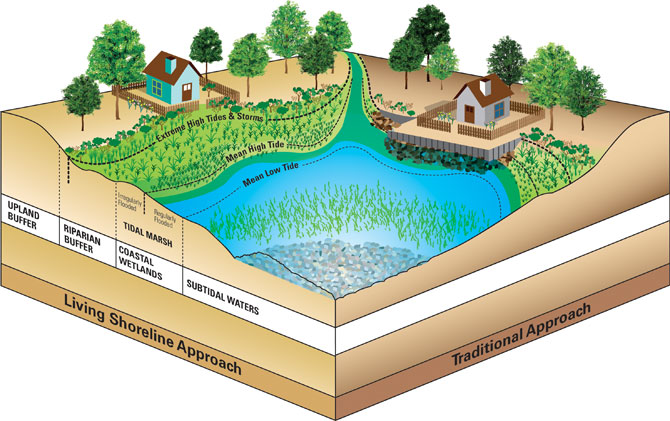There's a constant struggle taking place along our nation's coastal beaches. As in Louisiana's Lake Hermitage, our coastlines are struggling to find firm footing against the Herculean strength of storm waves that are causing widespread erosion.
For many years, we've pit manmade engineering genius against the forces of nature in a straightforward battle of strength. Usually that entailed building linear concrete or steel barriers to fend off the environment. Over time though, we've developed new ways of engineering with the environment, using and strengthening the natural defenses of coastal areas that have stood for eons.
The final result is something called a living shoreline, and it's becoming more popular along the Gulf Coast as a way to protect communities while enhancing the ecosystems that have long defined regional industry and culture.
What's In A Name?
It's easy to misinterpret "living" as a reference to the materials used (such as plants and bioengineered oyster reef) or how it supports local ecology. Both are true, but while the first is situational the second is mandatory. Living shorelines are non-linear barriers constructed to divert wave forces while facilitating tidal ebbs and flows.
This 2009 Dimensions article documents the different types of living shorelines and how they correspond with site conditions and tidal energy. While they usually incorporate local vegetation to form a riparian or marshland, plenty of living shorelines also incorporate "hard" materials, such as carefully placed boulders or hedgehogs (similar to the "X" angled I-beams that dotted the beaches of Normandy on D-Day). Though made up of non-living substances, they are classified as a living shoreline because of the way they facilitate tidal flows while providing a habitat for local ecology. The living shoreline of Aquia Landing is another example of how non-living breakwaters protect the land from erosion by interrupting destructive wave forces.

Creating a Living Shoreline Takes Time
Living shorelines have found homes along many Northeastern coastlines, and they're gaining in popularity along the Gulf Coast. For many years, living shoreline installation along the Gulf Coast consisted primarily of volunteer events. While these events have proven effective as a way to promote resilience awareness, these disconnected projects have led to a series of unconnected barriers that have trouble standing up to the forces of nature. Improperly designed living shorelines, even those made of boulders the size of your dining room table, can be dismantled by something as simple as the wake of a crew boat.
While there's little question that living shorelines provide natural buffers that interrupt wave forces, very little research has been done to develop an algorithm that correlates specific designs to reduced wave height. The process of securing resilience-based funding is difficult when there's no mathematical formula proving that, for example, 15 miles of newly planted mangroves reduce wave height by six inches along eight miles of a major tributary.
That's why it's more important than ever for the coastal engineering community to band together with environmentalist groups in an effort to understand the wave climate, tidal range, and coastal ecology of areas that would benefit from living shorelines. By working together, ecosystem restoration practitioners, environmentalists, and engineers can create long-lasting, sustainable storm barriers that put the power of nature on our side.